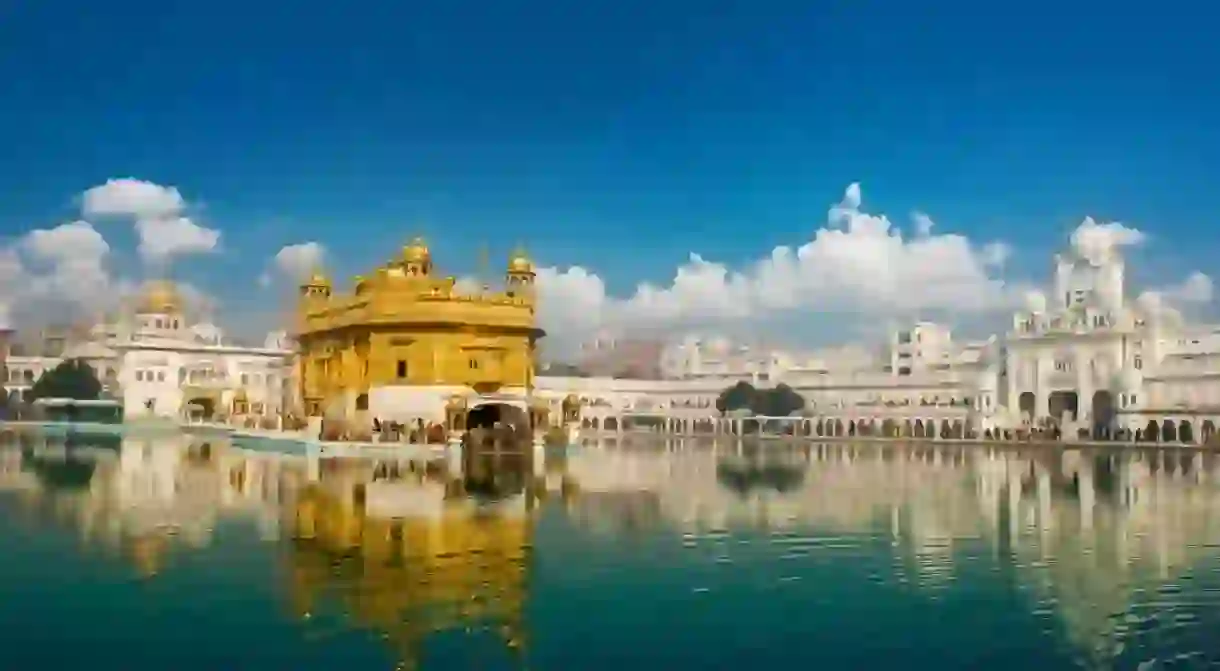Must-Visit Places in Amritsar, India

Amritsar is a must-visit city if you’re interested in honouring or just learning about Sikhism. This city in Punjab, which neighbours Pakistan, is considered the spiritual and cultural centre for this religion. In 1577, the fourth Sikh guru Ram Das founded the city, which is bisected by railway lines today. Here’s our pick of the top places to visit in Amritsar.
Partition Museum
Amritsar’s moving Partition Museum tells the story of the largest migration in human history. In 1947, the British divided the nation into two countries, India and Pakistan, displacing up to 20m people. More than a million people died from disease, massacres and famine, while many more lost everything they owned. The museum showcases newspaper clippings, photos and artefacts belonging to Partition survivors, along with stirring artwork and audiovisual stations that bring this torrid history to life.

Bharawan da Dhaba
You can’t come to Amritsar without dining at its most famous restaurant, Bharawan da Dhaba. The eatery has been a city staple since 1912 when it served up rich, buttery Punjabi dishes from a tent, and today, it’s still a family affair, with the original owner’s descendants running it. The restaurant, just 10 minutes from the sacred Golden Temple, serves only pure vegetarian food to reflect traditional Sikh values. Try the popular thalis, which feature channa, paneer and naan, followed by delicious cardamom-flavoured rice pudding.
Brothers Dhaba
Can’t get a seat at Bharawan da Dhaba? Head next door to another branch of the famous restaurant, run by the family’s eldest brother. You can expect all the Punjabi favourites served at the original restaurant, including parathas stuffed with herby potato, wafer-thin dosas and lassis. There’s also a sprinkling of western additions to the menu, and if you come for breakfast, opt for a special platter featuring curried potato and deep-fried kulcha (leavened flatbread).
Mata Lal Devi Temple
There’s no shortage of colourful Hindu temples in Amritsar, but Mata Lal Devi, in the Rani Ka Bagh area, definitely stands out from the crowd. Modelled on the Vaishno Devi cave temple, you’ll find a series of shrines and grottos mixed with mirrored mosaic walls and deity statues. At one point, you even pass through a lion’s mouth and exit through a snake’s head. Women from all over India come here to pray to the female saint Lal Devi for fertility.
Wagah Border Crossing
Wagah, known as the “Berlin Wall of Asia”, sits on the Grand Trunk Road, marking the dividing line between Pakistan and India. A retreat ceremony, the “lowering of the flags”, has taken place here every single evening since 1959 and is witnessed by hundreds of people every day on both sides of the border. It’s free to watch and starts 30 minutes before sunset. The Border Security Force (BSF) jawans (officers) encourage women and children to wave the national flag, run towards the gates and dance to lively Bollywood songs.
Hall Bazaar
Off Hall Road, the Hall Bazaar is the busiest shopping centre in Amritsar. This one-stop shopping destination stocks a wide range of products, including electronics, books, handicrafts, home decor and clothing. Many people visit to buy quality woollen items, too, such as carpets, blankets and shawls. You’ll also find great accessories here, including wooden bangles and fine silver jewellery. Hungry? It also houses many reputable restaurants and tasty food stalls.
Golden Temple
You haven’t seen the soul of Amritsar until you’ve visited the Golden Temple – the holiest shrine of the Sikh religion. Known to Sikhs as Harmandir Sahib or Darbar Sahib, the gurdwara is part of a larger complex. The Guru Granth Sahib (holy book of Sikhs) is taken to the temple every morning and returned to the Akal Takht, also in the complex, at night. Make sure you remove your shoes on entry and bring a suitable head covering.

Jallianwala Bagh
On 13 April 1919, British troops, on General Dyer’s order, opened fire on a group of innocent Indians participating in a meeting at the Bagh, killing hundreds. As you walk the narrow passage leading to the Jallianwala Bagh, the first thing you’ll notice is an inscription on a stone plaque: “People were fired at from here.” This park is now a memorial for those who sacrificed their lives, with bullet holes marked for visitors to observe.
Maharaja Ranjit Singh Museum
Sitting within a beautiful garden known as the Ram Bagh, this museum was once the summer palace of the first king of the Sikh Empire, Maharaja Ranjit Singh. Today, the museum holds a fascinating exhibit of arms, armour, old coins and manuscripts – items that relate to the king – while the paintings lining the galleries highlight his court and camp, giving insight into the palace’s history.
Central Sikh Museum
The Central Sikh Museum preserves the horrifying history of the Sikhs’ martyrdom at the hands of the Mughals, the British and Operation Bluestar. Established in 1958, the gallery houses a collection of portraits, including Sikh gurus, saints, warriors and prominent leaders, coins, arms and ancient manuscripts. You’ll also find a library.
Ram Tirath
About 11km (7mi) west of Amritsar is Ram Tirath, an ancient pilgrimage site associated with the period of Rāmāyana. It’s believed to be where Lord Rama and Sita’s twins, Luv and Kush, were born and where Valmiki wrote the epic Rāmāyana – the poet’s old hut is still on the grounds. This sacred site also features a well believed to have been dug by the Hindu god Hanuman, a devotee of Rama.
Planning a trip to South Asia? Check out these bookable tours, trips and experiences in Amritsar, India
Amy Blyth contributed additional reporting to this article.













